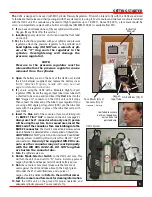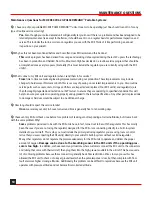
11
11
AUTO COMPENSATION INFORMATION
EDS O2D2-2G Auto-compensation
Altitude compensated breathing sensor
Because absolute atmospheric pressure lessens as a function of altitude, breathing efforts assert less pressure upon breath-
ing sensors to the point at which they may not properly detect breathing while at higher altitudes. Additionally, as the partial
pressure of CO2 drops below a normalized point with altitude, one’s breathing efforts also diminish. With these two physical
and physiological effects while ascending to higher altitudes, it becomes necessary for the EDS to compensate for this.
The EDS has an active algorithm that constantly and automatically makes breathing sensor sensitivity adjustments based on
detected pressure altitude changes and breathing efforts. This helps ensure that all breaths are detected and responded to
with the proper amount of oxygen without mis-triggering from artifacts. There are no user settings for this function as it is
entirely automatic.
Automatic respire-metric compensation
An adult person of average size (with no compromising pulmonary conditions or illnesses) will have an average respiration
rate between 12 and 18 breaths per minute. Persons between 60 and 75 years of age will generally have a rate between 12
and 28 breaths per minute. The respiration effort at rest generally becomes less as the rate increases. Shallow breathing with
elevated respiration rates are also typical with exposure to lower partial pressures from altitudes and/or anxiety.
With exposure to lower partial pressures from excursions to higher altitudes, breathing efforts will generally lessen as the
partial pressure of CO2 drops along with other atmospheric gases. Respiration is primarily controlled by chemoreceptors that
detect dissolved CO2 in the blood. Higher CO2 levels, from physical work, trigger higher respirations until CO2 is re-normal-
ized. Oxygen levels increase from this as well. Therefore, as the amount of dissolved CO2 reduces in the blood so does the
need to respirate. Unfortunately, this also exacerbates hypoxia as less oxygen is inhaled and admitted into the blood as the
body has no reason to respirate to expel any more CO2.
The EDS has a poly-metric method of dynamically adjusting the amount of oxygen delivered on a breath-by-breath basis as a
function of detected pressure altitude, respiration rate and (in some cases) breathing efforts. Without actually complement-
ing respiration with a small amount of CO2 at higher altitudes to encourage respiration, the EDS will dynamically augment
the amount of oxygen delivered to help ensure that each individual person’s breathing profile is complemented with a
‘best-effort’ schedule of needed oxygen while at higher altitudes. If the EDS is unable to establish meaningful respiremetrics
caused by pneumatic artifacts or mis-fitting cannulas and/or face masks for the current user, it will default to known param-
eters to cover a known mean pulmonary profile.
Compensating for various plenum volumes associated with face masks
A face mask, unavoidably, has a volume of space (plenum) that does not directly contribute to the admission of oxygen. This
plenum can compromise the initial admission of oxygen by allowing the user to re-breathe CO2 rather than oxygen at the
most important point of the inhalation phase, displacing some of the pulse of oxygen. While a small amount of re-inhaled
CO2 can actually be beneficial at higher altitudes as it encourages respiration, missing the full complement of the prescribed
amount of oxygen at altitude is not.
The EDS has four manually operated F-Mode settings, 1 through 4, that provide an additional bolus of oxygen with each
breath to help mitigate this. Each setting provides a progressively larger bolus. This is intended to be used to compensate for
the plenum volume associated with the use of face masks settings 1-2 for small sized masks, 2-3 for medium sized masks
and 3-4 for use with large sized masks. These F-Mode settings can also be used if the user determines that they may need
more oxygen than is automatically pre
scribed.


































